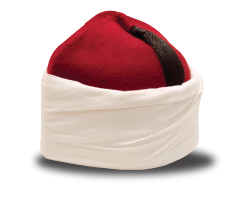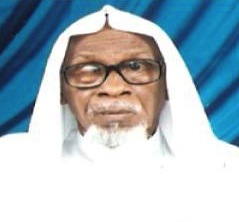Memoir Eng
Chapter 20: Halaqah at Nabawi Mosque
بَابُ نُزُولِ عِيسَى ابْنِ مَرْيَمَ حَاكِمًا بِشرِيعَةِ نَبِيِّنَا مُحَمَّدٍ صَلَّى اللهُ عَلَيْهِ وَسَلَّمَ
حَدَّثَنَا قُتَيْبَةُ بْنُ سَعِيدٍ، حَدَّثَنَا لَيْثٌ، ح، وَحَدَّثَنَا مُحَمَّدُ بْنُ رُمْحٍ، أَخْبَرَنَا اللَّيْثُ، عَنِ ابْنِ شِهَابٍ، عَنِ ابْنِ الْمُسَيِّبِ، أَنَّهُ سَمِعَ أَبَا هُرَيْرَةَ، يَقُولُ: قَالَ رَسُولُ اللهِ صَلَّى اللهُ عَلَيْهِ وَسَلَّمَ: «وَالَّذِي نَفْسِي بِيَدِهِ، لَيُوشِكَنَّ أَنْ يَنْزِلَ فِيكُمْ ابْنُ مَرْيَمَ صَلَّى اللهُ عَلَيْهِ وَسَلَّمَ حَكَمًا مُقْسِطًا، فَيَكْسِرَ الصَّلِيبَ، وَيَقْتُلَ الْخِنْزِيرَ، وَيَضَعَ الْجِزْيَةَ، وَيَفِيضُ الْمَالُ حَتَّى لَا يَقْبَلَهُ أَحَدٌ» وَحَدَّثَنَاهُ عَبْدُ الْأَعْلَى بْنُ حَمَّادٍ، وَأَبُو بَكْرِ بْنُ أَبِي شَيْبَةَ، وَزُهَيْرُ بْنُ حَرْبٍ، قَالُوا: حَدَّثَنَا سُفْيَانُ بْنُ عُيَيْنَةَ، ح، وَحَدَّثَنِيهِ حَرْمَلَةُ بْنُ يَحْيَى، أَخْبَرَنَا ابْنُ وَهْبٍ، قَالَ: حَدَّثَنِي يُونُسُ، ح، وَحَدَّثَنَا حَسَنٌ الْحُلْوَانِيُّ، وَعَبْدُ بْنُ حُمَيْدٍ، عَنْ يَعْقُوبَ بْنِ إِبْرَاهِيمَ بْنِ سَعْدٍ، حَدَّثَنَا أَبِي، عَنْ صَالِحٍ، كُلُّهُمْ عَنِ الزُّهْرِيِّ، بِهَذَا الْإِسْنَادِ، وَفِي رِوَايَةِ ابْنِ عُيَيْنَةَ: «إِمَامًا مُقْسِطًا، وَحَكَمًا عَدْلًا» وَفِي رِوَايَةِ يُونُسَ: «حَكَمًا عَادِلًا»، وَلَمْ يَذْكُرْ «إِمَامًا مُقْسِطًا»، وَفِي حَدِيثِ صَالِحٍ: «حَكَمًا مُقْسِطًا»، كَمَا قَالَ اللَّيْثُ: وَفِي حَدِيثِهِ مِنَ الزِّيَادَةِ: «وَحَتَّى تَكُونَ السَّجْدَةُ الْوَاحِدَةُ خَيْرًا مِنَ الدُّنْيَا وَمَا فِيهَا»، ثُمَّ يَقُولُ أَبُو هُرَيْرَةَ: اقْرَءُوا إِنْ شِئْتُمْ: {وَإِنْ مِنْ أَهْلِ الْكِتَابِ إِلَّا لَيُؤْمِنَنَّ بِهِ قَبْلَ مَوْتِهِ} [النساء: 159] الْآيَةَ…
Zul recited the 242nd hadith from Sahih Muslim which compiles the hadiths related to the return of Prophet Jesus alaihissalam in front of his teacher, Syeikh Muhammad bin ‘Ali Muhammad Thani who is the imam and teacher in the Nabawi Mosque. The Syeikh was born in Medina al-Munawwarah in 1920 and starts his teaching career in the year 1958/1959. His class begins after the maghrib prayer. Sometimes, he would also deliver a general or public sermon.
“Yasir, whenever you are free, you can join the talaqqi with Syeikh Muhammad ‘Ali Thani. We’ll learn Sahih Muslim and Fath al-Bari. After ‘Asar, you enter the mosque from Bab al-Salam, take a left, and walk for about 30 metres, then you’ll see me and syeikh at the pillar. There aren’t many who follow his class, just 20-25 students. The majority of them are Africans, all elderly…”. Zul invites his friend Yasir who is also the son of Sabah’s Mufti, Sahibus Samahah Dato’ Haji Ismail Abbas.
Such is Zul’s daily routine from his first week in Medina until he completed his studies in the year 1993. In the morning, Zul would attend his lectures and classes on campus, in the evening till late at night he would study diligently through his talaqqi classes in Nabawi mosque. He’s greatly motivated by the statement of Rasullullah PBUH regarding the favours on those who learn and attend classes at Nabawi Mosque. Rasullullah PBUH said:
مَنْ جَاءَ مَسْجِدِي هَذَا، لَمْ يَأْتِهِ إِلَّا لِخَيْرٍ يَتَعَلَّمُهُ أَوْ يُعَلِّمُهُ، فَهُوَ بِمَنْزِلَةِ الْمُجَاهِدِ فِي سَبِيلِ اللَّهِ، وَمَنْ جَاءَ لِغَيْرِ ذَلِكَ فَهُوَ بِمَنْزِلَةِ الرَّجُلِ يَنْظُرُ إِلَى مَتَاعِ غَيْرِهِ
“Whoever comes to this mosque of mine, and only comes for a good purpose, such as to learn or to teach, his status is like that of one who fights in Jihad in the cause of Allah. Whoever comes for any other purpose, his status is that of a man who is keeping an eye on other people’s property.” [1]
In another narration, it is stated:
مَنْ دَخَلَ مَسْجِدَنَا هَذَا لِيَتَعَلَّمَ خَيْرًا، أَوْ لِيُعَلِّمَهُ، كَانَ كَالْمُجَاهِدِ فِي سَبِيلِ اللهِ، وَمَنْ دَخَلَهُ لِغَيْرِ ذَلِكَ، كَانَ كَالنَّاظِرِ إِلَى مَا لَيْسَ لَهُ
“Whoever comes to this mosque of mine, to learn or to teach goodness, his status is like that of one who fights in Jihad in the cause of Allah. Whoever comes for any other purpose, his status is that of a man who is keeping an eye on other people’s property.” [2]
“For your information, when the Prophet PBUH said ‘whoever comes to this mosque of mine’ he meant Nabawi mosque, for at that time only Nabawi mosque is a place to learn. Syikeh Muhammad bin ‘Abd al-Hadi al-Sindi likened a mosque to a knowledge market. Whoever went to the mosque is like a person who buys knowledge through learning and teaching. [3] This is the great advantage of learning through talaqqi in Nabawi mosque…,” Zul continues his conversation with Yasir one evening in Mat’am Hana’. They were together with Abdul Basit, Hamid, Zaini and Shohor Bani. For Malaysian students from Medina, the Bukhari Rice restaurant is well-known as the first choice as the place to eat. It has a simple menu; Bukhari Lamb and Bukhari Roast Chicken Rice with salatah [4] and raw onion, served in a large tray on top of a large plastic spread. After eating till they are stuffed, they were then served with Pepsi. Simple yet fulfilling! For almost every program organized by Malaysian Medina Student Association, the same menu is ordered for the feast. It is also the time students wait in anticipation for the opportunity to eat a free delicious meal.
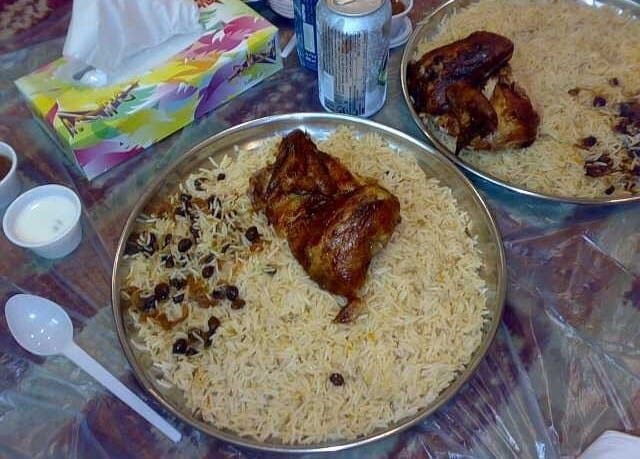
Throughout his four years of study in Medina with Syeikh Muhammad ‘Ali, Zul managed to finish his study of the books Fath al-Bari Syarh Sahih al-Bukhari volume 12-13 and 4 volumes of Sahih Muslim of which only 2 volumes remained before he completes them all. Other than these two books, he also attended the course on the book Tafsir al-Qur’an al-‘Azim and Fath al-Qadir which was taught by the same teacher. Syeikh also teaches the book Tafsir al-Baghawi.
“Zulkifli, have you received your allowance?” Syeikh Muhammad ‘Ali Thani asked him one night after the Tarawih prayer. Zul smiled and shook his head. He’s shy to say so in front of his teacher.
“Go to my assistant. He’s a bit on the hefty side, dark-skinned and always waits by the pillar over there wearing a yellow misylah[5]. Go, now…” The Syeikh said, gesturing with his hands the physical of his heavyset assistant. Zul went to the specified place and met with a broad-shouldered man, with dark skin and wearing a yellow misylah with red syimagh wrapped neatly on his head, tied together with an igal. [6] It was awkward for Zul to suddenly strike a conversation with the guy. At a glance, the guy is quite intimidating. His hands alone are several times bigger than the hands of an Asian.
He gave Zul a once over, then said, “You’re Syeikh Muhammad ‘Ali Thani’s student? Istanna syuwayya.” [7] gesturing a common hand symbol of the Arabs with his hands. He jogged towards a wall and takes out his small pouch and counted the money notes he kept. He turned back towards Zul and gave him a handful of thick Saudi Royal notes. As Zul reaches his dormitory, he counted the money he received one by one. “Masya-Allah, there are more than a thousand riyals here…!!!” Zul muttered in disbelief alone. Almost every year the Syeikh would give some allowance for Zul. And with that money, he used it to pay for his expenses, to buy books and keep, apart from the scholarship awarded by the Islamic University of Medina which totalled SAR520 a month.
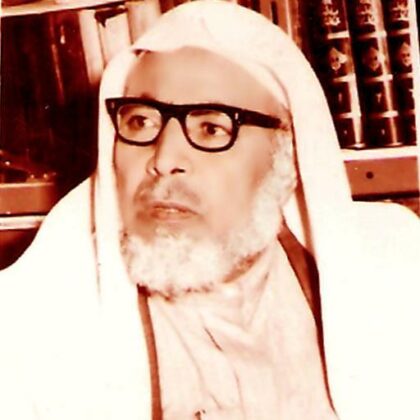
Syeikh ‘Atiyyah Salim
Other than Syeikh Muhammad ‘Ali Thani, Zul also attended classes by Syeikh ‘Atiyyah Salim who taught al-Muwatta’ and Bulugh al-Maram min Adillat al-Ahkam. The Syeikh was born in 1925 in a village named Al-Mahdiyyah, Egypt. There were other Malaysian students who attend these classes such as ‘Abdul Basit and Hamid. Syeikh ‘Atiyyah Salim’s voice was louder than the voice of Syeikh Muhammad ‘Ali Thani. He also taught al-Arba’in al-Nawawiyyah, Al-Baiquniyyah, Al-Rahabiyyah, Al-Waraqat andd tafsir al-Qur’an. His language style and proficiency in answering questions made Syeikh ‘Atiyyah a famous teacher and the student’s favourite.
Originally, a chair is reserved specifically by Nabawi Mosque for lecturers from the Islamic University of Medina known as the “Jami’ah Chair”. The seat is usually the place for Syeikh Muhammad al-Amin al-Syinqiti and Syeikh Abd al-‘Aziz bin Abdullah bin Baz. Syeikh Muhammad al-Amin al-Syinqiti was later replaced with Syeikh ‘Abd al-Qadir Syaibat al-Hamd after he’s aged. Due to the busy schedule as the rector of the Islamic University of Medina, Syeikh Abd al-‘Aziz bin Abdullah bin Baz asked Syeikh ‘Atiyyah Salim to replace him and this continues until the Jami’ah chair become synonymous with him.
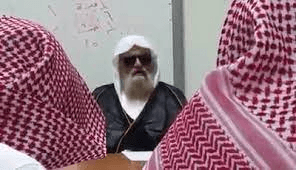
Syeikh ‘Abd al-Muhsin ‘Abbad
Zul will sometimes attend the Sahih al-Bukhari lesson and question and answer session given by Syeikh ‘Abd al-Muhsin bin Hammad al-‘Abbad al-Badr, who is also a lecturer at the Islamic University of Medina. He was born in 1934 in Zulfa, and was appointed as Islamic University of Medina’s lecturer by Syeikh Muhammad bin Ibrahim Aal al-Syeikh, Saudi Arabia’s Grand Mufti. [8] His eloquence in speech and istinbat ruling from the Quran and hadith is truly amazing.

Syeikh Abu Bakr Jabir al-Jaza’iri
At a nearby pillar, another halaqah by Syeikh Abu Bakr Jabir al-Jaza’iri taught Aisar al-Tafasir which is a book he wrote himself. [9] He was born in the year 1921 and was given permission to teach in Nabawi Mosque by Medina’s Qadhi Office. He is a teacher at several schools, a lecturer at Islamic University Medina and once worked at the Education Ministry of Saudi Arabia. If one ever passes through the Raudhah area, one would surely hear the voice of Syeikh ‘Umar bin Hasan bin Uthman Fallatah. [10] He taught the book Sahih Muslim, Syarah Usul al-I’tiqad Ahl al-Sunnah wa al-Jama’ah dan al-Adab al-Mufrad. There are some who confused him with Syeikh Dr. ‘Umar bin Muhammad Fallatah [11] who teaches Sahih Muslim, Tafsir al-Qur’an al-‘Azim, Sunan Abu Daud, al-Syama’il al-Muhammadiyah and Nail al-Autar, for both of them share the same name. At times, Syeikh ‘Ali al-Huzaifi, an imam and khatib in Nabawi Mosque will also teach al-Muntaqa min Akhbar al-Mustafa, Tafsir al-Qur’an al-‘Azim, Nail al-Autar, Jami’ al-‘Ulum wa al-Hikam dan Zad al-Mustaqni’.
If there were any scholars from Riyadh who came to visit, several syeikhs will empty their seats giving way for the scholars to give their lectures. There is also halaqah where there is only a small number of students attending them. Once, there was only a single student who was present for a class by Syeikh ‘Abd al-Majid Hasan al-Jabarti. If ever Zul was free, he would join the halaqah. Nonetheless, the Syeikh will continue to give his lecture enthusiastically. Such is the beauty of the gardens of paradise at Nabawi Mosque, the mosque that never sleeps of which every second is spent spreading the knowledge of Allah SWT.
************
Khairul vividly remembers the answer his brother Zul gave him when he asked whether he should enrol in SMAASZA or not. Zul said, “You should enrol in Maahad tahfiz. Memorize the Quran. None in our family got into a Maahad Tahfiz. Mi, Yah and I all were enrolled in SMAASZA. Why should all of us go to just the same school…?” He had planned to follow in his brother’s footsteps to continue his studies at the Islamic University of Medina after his brother Mi and sister Yah completed their studies at al-Azhar University.
“If you’re serious about getting into the Islamic University of Medina, make sure you’re placed first at the Maahad Tahfiz. I’ll take care of all the documents needed. I’m close with Syeikh mahmud Qadah….” Khairul read the letter sent by his brother from Medina. The whole time Zul was studying at the Islamic University of Medina, Zul sent several letters back home to his family, asking how they were doing and told them of his daily life there. Khairul also sent letters to his brother. He asked how his brother is coping studying at the campus who uses Arabic as their only language on campus. Zul replied to the letter saying that he understood 85-90% of the lectures in the university. This motivates and ignites a fire of determination in Khairul to also continue his studies at the same university as his brother.
Zul turned over the letter his brother sent him, smiling. At least, he knew that his parents are fine back home. He left the radio turned on, playing the sermon given by the masyaikhs from across Saudi Arabia. When he hears of any interesting fatwa especially from the program Nur ‘ala al-Darb which is broadcasted after Isya’ by Saudi’s Lajnah Hai’ah Kibar Ulama’, Zul would immediately write it down in his notebook.
“Hopefully, next year Khairul will get in here. He could drive me around. Next week I’m going to buy a second-hand Mazda 929…” Zul whispered in his heart before falling asleep.
_______________________________
[1] Sunan Ibn Majah, no.227 [2] Musnad Ahmad, no.8603 [3] Hasyiah al-Sindi ‘ala Sunan Ibn Majah, 100-101/1 [4] Arabian salad [5] Outer jubah [6] Head loop worn on top of syimagh [7] Please wait a second [8] Follow his recorded sermons at http://www.alharamain.gov.sa//index.cfm?do=cms.scholarsubject&schid=9636&subjid=31339&audiotype=lectures&browseby=speaker [9] Follow his recorded sermons at https://www.alharamain.gov.sa/index.cfm?do=cms.scholarpage&schid=2653&type=all [10] Follow his recorded sermons at http://www.alharamain.gov.sa/index.cfm?do=cms.scholarpage&schid=23039&type=all [11] Follow his recorded sermons at http://www.alharamain.gov.sa/index.cfm?do=cms.scholarpage&schid=23039&type=all